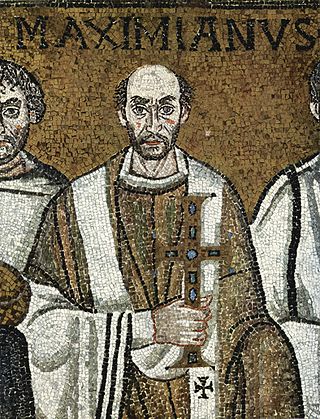The 520s decade ran from January 1, 520, to December 31, 529.

Year 526 (DXXVI) was a common year starting on Thursday of the Julian calendar. At the time, it was known as the Year of the Consulship of Olybrius without colleague. The denomination 526 for this year has been used since the early medieval period, when the Anno Domini calendar era became the prevalent method in Europe for naming years.
Pope John I was the bishop of Rome from 13 August 523 to his death. He was a native of Siena, in Italy. He was sent on a diplomatic mission to Constantinople by the Ostrogoth King Theoderic to negotiate better treatment for Arians. Although John was relatively successful, upon his return to Ravenna, Theoderic had him imprisoned for allegedly conspiring with Constantinople. The frail pope died of neglect and ill-treatment.
Theodore II was Exarch of Ravenna from 677 to 687.
Theophylact was Exarch of Ravenna from 701 or 702 to 709, succeeding John II Platinus.

The Basilica of Sant' Apollinare in Classe is a church in Classe, Ravenna, Italy, consecrated on 9 May 549 by the bishop Maximian and dedicated to Saint Apollinaris, the first bishop of Ravenna and Classe.

The Basilica of San Vitale is a late antique church in Ravenna, Italy. The sixth-century church is an important surviving example of early Christian Byzantine art and architecture, and its mosaics in particular are some of the most-studied works in Byzantine art.. It is one of eight structures in Ravenna inscribed on the UNESCO World Heritage List. Its foundational inscription describes the church as a basilica, though its centrally-planned design is not typical of the basilica form. Within the Roman Catholic Church it holds the honorific title of basilica for its historic and ecclesial importance.
Andreas Agnellus of Ravenna was a historian of the bishops in his city. The date of his death is not recorded, although his history mentions the death of archbishop George of Ravenna in 846; Oswald Holder-Egger cites a papyrus charter dated to either 854 or 869 that contains the name of a priest named Andreas of the Church of Ravenna, but there is no evidence to connect him with Andreas Agnellus.
This page is a list of Catholic bishops and archbishops of Ravenna and, from 1947 of the Archdiocese of Ravenna and Cervia, which in 1985 became styled the Archdiocese of Ravenna-Cervia. The earlier bishops were frequently tied to the Exarchate of Ravenna.

Maximianus of Ravenna, or Maximian was bishop of Ravenna in Italy. Ravenna was then the capital of the Byzantine Empire's territories in Italy, and Maximianus's role may have included secular political functions.
Eleuchadius is a 2nd-century Christian saint venerated by the Roman Catholic and Eastern Orthodox Churches. He served as the third bishop of Ravenna from 100 to 112.
Adheritus was Bishop of Ravenna during the 2nd-century and successor to Saint Apollinaris, the first bishop of Ravenna. He was of Greek origin and was a follower of Apollinaris Adheritus died on 27 September at the port of Classe, and his remains are venerated in the Basilica of Sant'Apollinare in Classe near Ravenna, Italy

Ursicinus is a saint of the Catholic Church and was Bishop of Ravenna from 533 to 536. He is not to be confused with the 1st-century saint Ursicinus of Ravenna.

Classe was a commercial port located 4 km (2.5 mi) east south east from Ravenna, Italy. It was near the head of the Adriatic coast. For almost five hundred years it was an important strategic military port. When it was not being used as a military port, it was an important commercial port for the imperial capital of Ravenna in the Roman Empire. Classe comes from the Latin word classis, meaning fleet.
Ostrogothic Ravenna refers to the time period in which Ravenna, a city in Northeastern Italy, served as the capital of the Ostrogothic Kingdom, which existed between 493 and 553 CE. During that time, Ravenna saw a great renovation, in particular under Theodoric the Great (454–526). During his rule, Ravenna saw many of its finest monuments constructed or renovated, including the Basilica of Sant'Apollinare Nuovo, the Palace of Theoderic, and Mausoleum of Theodoric. Many of these monuments reflect the Arian faith of Theodoric and the Goths. Though an Arian Christian himself, Theodoric's rule was a time of religious tolerance in the city of Ravenna. His religious tolerance extended also to forging a balance between the Romans and Goths in Ravenna. Theodoric attempted to model Ravenna as a capital equivalent to that of Rome or Constantinople and as such was a defender of classical antiquity in a western world that saw much of its classical heritage disappearing.
Agnellus was a bishop of Ravenna in the Praetorian prefecture of Italy from 557 to his death. The main source about him is by Liber Pontificalis Ecclesiae Ravennatis by Andreas Agnellus.
Claudius Postumus Dardanus was a praetorian prefect of Gaul from the early fifth century AD, who was against Jovinus, considered as a usurper of imperial authority. Dardanus made him suffer the last penalty after he had been defeated in Valencia by King of the Goths Ataulf.

Ravenna Cathedral is a Roman Catholic cathedral dedicated to the Resurrection of Jesus Christ in the city of Ravenna, Italy. Formerly the archiepiscopal seat of the Archdiocese of Ravenna, it is now the seat of the archbishops of Ravenna-Cervia.
The following is a timeline of the history of the city of Ravenna in the Emilia-Romagna region of Italy.

Ursus was bishop of Ravenna during the late 4th century.









